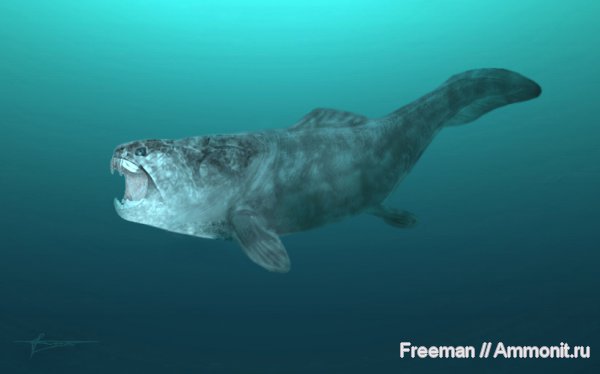
The gigantic arthrodire Dunkleosteus terrelli, Late Devonian (Famennian Age) of North America (Laurentia). Life reconstruction © Mikhail Tikhonov, original url
| Placodermi | ||
| The Vertebrates | Pachyosteomorphi |
| Vertebrates Home | Vertebrate | Vertebrate |
|
Abbreviated Dendrogram
Gnathostomata
│ └─Acanthodii etc (if traditional placement)
│
└─Placodermi
╞?═Acanthothoraci
├─Rhenanida
└─┬─Antiarchi
└─┬─┬─Petalichthyida
│ └─Ptyctodontida
└─┬─┬─Arthrodira
? ├─Actinolepidoidei
│ └─┬─Phlyctaenioidei
│ └─┬─Brachythoraci
│ └─┬─Coccosteomorphi
│ └─┬─Pachyosteomorphi
│ └─Aspinothoracidi
╘═Acanthodii
├─Chondrichthyes
└─Osteichthyes
|
Contents
Overview |
 The gigantic arthrodire Dunkleosteus terrelli, Late Devonian (Famennian Age) of North America (Laurentia). Life reconstruction © Mikhail Tikhonov, original url |
Dunkleosteus telleri is the type species of Dunkleosteus, a huge placoderm that lived in the late Devonian period, about 370 – 360 million years ago. It had a worldwide distribution, grew to around 6 meters (some sources say 8 to 10 metres) long, and was without doubt the apex predator or superpredator of its time.
Due to its heavily armoured nature, Dunkleosteus was likely a relatively slow (albeit massively powerful) swimmer. Popular thought suggests that they may have encountered stiff competition from the smaller yet swifter sharks, such as Cladoselache, who had then only recently evolved, though, few people seem to realize that the sharks and Dunkleosteus would have inhabited different ecological niches. It is presumed to have dwelled primarily in diversal zones, although it is unknown whether or not it was also somewhat pelagic. Fossilization tends to have only preserved the especially armoured frontal sections of specimens, and this creates uncertainty as to what exactly the hind sections of this ancient fish were like.
By Devonian standards, Dunkleosteus was highly evolved. It was one of the earliest jawed fishes. Instead of actual teeth, Dunkleosteus possessed two long, bony blades that could slice through flesh and snap and crush bones and almost anything else. It was a vicious hunter, and probably ate whatever it could find, including sharks and probably other Dunkleosteus. It was a glutton, as well. Oftentimes, fossils of Dunkleosteus are found with semi-digested and partially eaten remains of other fish. As a result, the fossil record indicates that it either suffered from acute indigestion, or that it routinely regurgitated prey bones rather than dissolving them. Dunkleosteus, like most other placoderms, may have also been among the first vertebrates to internalize egg fertilization, and thus sexually reproduce in the manner that most mammals and sharks do today.
Fossils have been found in Morocco, Belgium, Poland, and North America. Wikipedia
MAK111027